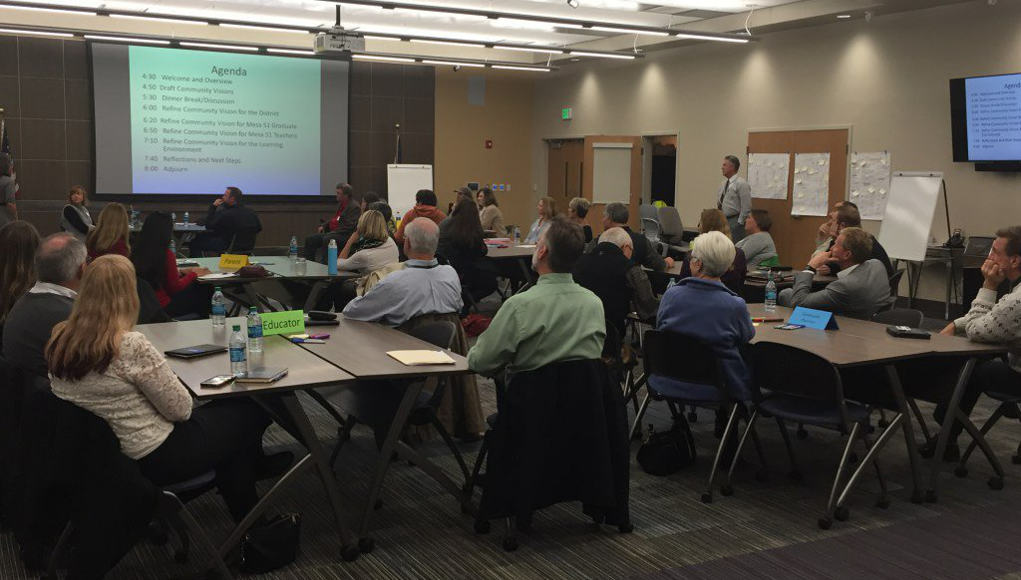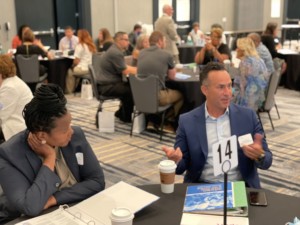Building Community Consensus for District Change

A version of this blog ran on CompetencyWorks as the second in a blog series sharing Mesa County Valley School District 51‘s journey as it shifts to a competency-based education model (D51 uses the phrase performance-based learning).
One of the more challenging processes for medium to larger districts (as compared to the small ones that have led the way to competency-based education) is engaging the broader community in building the consensus for change.
In general, when it comes to shifting course or introducing new reforms in larger districts, buy-in tends to be the most common strategy used; there is a single or big meeting with community members, presentation of the new idea, opportunity to react – and then it moves quickly into implementation.
Engagement means that there are continued opportunities for community members to shape the “what” of competency education and that there are ongoing structures and processes for two-way dialogue. Mesa County Valley School District 51 in Grand Junction, Colorado (the seventh largest school district in the state) is currently shifting to a competency-based education (CBE) model, and leadership is working with the community for input through the entire process.
Superintendent Steve Schultz explained, “We want to move from a ‘decide and defend’ mentality to one in which we gather information to inform a decision before it is made.” Below are highlights of how D51 is doing this–building consensus and shaping community engagement.
A Bit Of D51 Background
Schultz had been guiding D51 toward personalization since 2006, when the school established three diploma pathways (normal, distinction and individualized) with the district expanding the number of options and instructional pathways (IB, concurrent enrollment, STEM, Key Performance Program to demonstrate learning through capstones and presentations and four alternative education programs).
The emphasis was on helping students excel just as much as it was on increasing pathways for students who were having problems earning credits, were confronted with challenging life experiences or had left school for a period of time to complete their diploma.
In 2013, when Schultz began to engage his team in learning about competency education, the communities in the area were still challenged by the Great Recession. A region shaped by the boom and bust cycles of the oil industry, Grand Junction and the surrounding towns were having difficulty climbing out of the bust. Vast ideological differences had led to relationships becoming increasingly strained between the teachers’ association, administration and the school board. Schultz said, “It became clear to us that we needed to focus on building relationships and finding common ground in order to move the district forward.”
Then two things happened: the 2011 D51 school board election and a team visit to Lindsay Unified School District.
From School Board to Learning Board
The D51 school board election opened the door to creating a “learning board” where members worked together to do what is right for D51 learners. They were open to learning from each other’s perspectives, shaping a vision that was beyond any one single political ideology. In this election, what had previously been a board sharing one ideology now became a group of board members bringing together a mix of ideologies.
Board members found that they needed to be more collaborative. It wasn’t that the new board members had a better or stronger ideology – it was that it shook up the hold of one way of thinking and opened up opportunities for board members to engage with each other. If we use our color-coded political system, you would describe the board as two reds and three blues all willing to think about shades of purple if it was best for kids.
The five board members began a formal study and reflection on how the world was changing. They began to ask themselves, How are we as a community preparing our students for a rapidly changing world? They came to terms with the fact that the public education system isn’t broken–it’s obsolete.
The internet has made knowledge and information easy to get and find any place and any time. Jobs are being automated and future career opportunities lie more in technical occupations. Technology is making the world more customized. It’s opening up new ways to personalize. The global economy is increasing competition for the good jobs. We can’t tolerate our children simply getting through the system; they need to be able to demonstrate mastery so they are fully prepared for college and careers.
The focus of the board shifted from what it thought government shouldn’t do to what it can do.
A Trip to Lindsay
Superintendent Steve Schultz sent a party of four – Darren Cook, then Mesa Valley Education Association’s president; Board members Jeff Leany and Greg Mikolai; and Chief Academic Officer Tony Giurado – off to Lindsay Unified School District in California to see personalized, performance-based learning in action: a model he hadn’t seen himself. He trusted this team to be learners, to share and listen to each other’s perspectives, and to bring back their insights without bending them around their own agendas.
All four returned from Lindsay and other site visits inspired and excited. After subsequent visits to Lindsay by other teams, Steve Schultz was amused to learn that some board members wanted full implementation by next fall. “Of course the board members wanted to do it now, next year. How do we go about implementing this? I knew we were facing a transformation, not an add-on program. It couldn’t be done next year. We had to set realistic expectations.”
The Visioning Process: Respectfully Engaging The Community
Currently, D51 is in the midst of an intentional community engagement process to create three important design nodes (ideas that guide the development of the system and intersect with other ideas and frameworks) for the performance-based system by the end of 2017. The are creating the following in this order:
- A graduate profile that captures the hopes and dreams of what the community wants for their children when they graduate. This profile will be used to help shape the graduation competencies as well as inform the pedagogy and mix of learning experiences students will need over time.
- A shared vision that includes embedded metrics to guide the district.
- A set of guiding principles to use for decision making.
This work establishes one of the hallmarks of local control: mutual accountability. The school board is accountable to the community through elections; however, the shared vision creates mutual accountability.
The first set of community engagement sessions, initiated in 2016, invited parents of seventh graders as well as the broader community to respond to the following questions in order to create the graduate profile:
- How has the world changed in 30 years?
- What skills will the future workforce require?
- How well are we preparing students now?
- What can the district do to improve?
In developing the vision and guiding principles, D51 has brought in Colorado Education Initiative to help facilitate. The vision and mission of the district hadn’t been updated since 1999, so D51 is taking this opportunity to also create a planning process that involves the community throughout the year. In December 2016, the draft vision was presented: Engage, Equip and Empower our learning community today for an unlimited tomorrow.
At D51, each of the seven demonstration schools are also engaging their community in creating their school’s shared vision. New Emerson Elementary School’s principal Terry Schmalz explained, “It is a powerful process when community members and parents and educators come together to create a shared vision for a school. It took us a year because we wanted rich participation. We don’t do buy-in, we do shared leadership.”
A version of this blog ran on CompetencyWorks as part of the Designing Performance-Based Learning at D51 series.
For more, see:
- Growing Into The Framework: A District’s CBE Implementation Strategy
- The Vision of Performance-Based Education at District 51
- Getting Smart Podcast | District 51 On Building a Performance-Based Education System
Stay in-the-know with all things EdTech and innovations in learning by signing up to receive the weekly Smart Update. This post includes mentions of a Getting Smart partner. For a full list of partners, affiliate organizations and all other disclosures please see our Partner page.







0 Comments
Leave a Comment
Your email address will not be published. All fields are required.